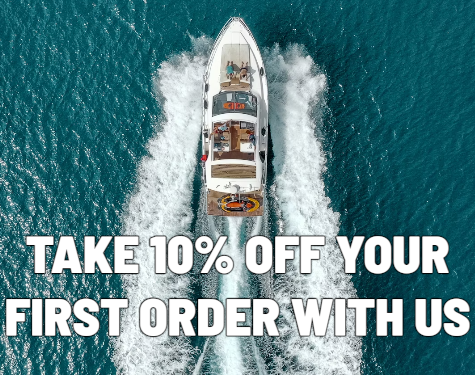How to Choose the Right Propeller for Your Boat
1st Aug 2025
Choosing the correct boat propeller isn’t just about speed — it’s essential for fuel efficiency, engine health, and overall performance. Whether you're boating for leisure or sport, the right propeller helps you get the best out of your outboard motor.
In this guide, we’ll walk you through the key factors to consider when selecting a propeller and how to make the right decision based on your boat type and engine.
Why the Right Propeller Matters
A properly matched propeller allows your engine to operate within its recommended RPM range. A mismatched one can cause engine strain, poor fuel economy, and reduced top-end performance. It can also lead to early wear and damage.
Understanding Propeller Basics
Blade Count and Shape
Most propellers have 3 or 4 blades:
- 3-blade props are standard and offer good all-around performance.
- 4-blade props provide better grip in the water, improved hole shot (acceleration), and are ideal for heavier boats or choppy waters.
Diameter and Pitch
- Diameter is the total width of the propeller.
- Pitch is the theoretical distance the propeller would move in one full rotation.
A lower pitch gives more torque and faster acceleration, while a higher pitch offers better top-end speed.
Factors to Consider When Choosing a Boat Propeller
1. Engine Type and Horsepower
The size and power of your outboard engine directly influence the type of propeller you should use. For example, if you have a Yamaha outboard, you'll need a prop that aligns with its specific RPM range and gear ratio.
Explore compatible Yamaha Outboard Propellers.
2. Boat Usage
Are you towing skiers, cruising offshore, or fishing in shallow estuaries? Your boating style affects prop selection:
- Watersports: Go for a lower-pitch prop for stronger take-off.
- Cruising: Choose a propeller optimised for higher speeds and fuel efficiency.
3. Material: Aluminium vs. Stainless Steel
- Aluminium: Affordable, lightweight, and good for everyday use.
- Stainless Steel: More durable, offers better performance and longevity — ideal for frequent or high-performance boating.
4. Rotation Direction
Some twin-engine setups require a counter-rotating prop to reduce steering torque. Always match the rotation to your engine setup.
5. Propeller Hub Types and Their Importance
The hub is the central part of a propeller that fits onto the prop shaft. There are different hub systems, such as pressed-in rubber hubs and interchangeable hub kits like Flo-Torq or Rubex. Interchangeable hubs make it easier to switch propellers across different engines or replace just the hub if it's damaged.
6. Cavitation and Ventilation – What to Watch For
Two common propeller-related issues are cavitation and ventilation. Cavitation occurs when water pressure drops around the blades, forming bubbles that can cause damage. Ventilation, on the other hand, is when air or exhaust gases are pulled into the propeller blades, causing loss of thrust. Both can be symptoms of an incorrect propeller size, damaged blades, or poor engine height setup.
7. How Load and Elevation Affect Prop Performance
Heavily loaded boats need more torque, which a lower-pitch propeller can provide. Similarly, if you're boating in high-altitude areas, where water is less dense, your engine may struggle to perform. Adjusting your propeller for load and elevation can help maintain optimal RPM and efficiency.
8. Don’t Overlook the Propeller Hardware
When upgrading or replacing your prop, check the condition of washers, cotter pins, and thrust hubs. Worn-out hardware can cause vibrations or allow the prop to spin off. Boaters World also supplies propeller hardware kits to ensure safe and secure installations.
9. When to Consider Dual Propeller Setups
For larger vessels or high-performance boats, Volvo Penta dual propeller systems can significantly improve acceleration, handling, and fuel efficiency. Though more expensive, they’re ideal for offshore anglers or water sports enthusiasts looking for maximum thrust and balance. Note a duo propeller is a factory fitted item only. No duo propeller system replaces a single propeller.
How to Test Propeller Performance
It’s not always a one-size-fits-all decision. A sea trial can help:
- Note your RPM at wide-open throttle (WOT)
- Check speed and fuel consumption
- Evaluate handling during acceleration and turns
This helps determine if the pitch or diameter needs adjusting.
When to Replace or Upgrade Your Propeller
Signs you may need a new prop:
- Bent, cracked or chipped blades
- Difficulty reaching recommended RPM
- Poor acceleration or top speed
- Unusual vibration or cavitation
Browse our full range of Boat Propellers including options for Yamaha, Mercury, Evinrude and Suzuki outboards.
FAQs
What happens if I choose the wrong boat propeller?
An incorrect prop can lead to poor fuel efficiency, engine overloading, and diminished performance.
How do I know what size propeller I need?
Start by checking your current prop’s pitch and diameter — usually stamped on the hub. Use your engine's manual or a prop calculator for guidance.
Can I switch from aluminium to stainless steel?
Yes. Stainless steel props are generally compatible with engines that use aluminium props, but consult your engine’s specifications for confirmation.
How often should I replace my propeller?
Inspect your propeller every season. Replace it if there’s visible damage or if performance significantly drops.

 Australian Dollars
Australian Dollars

